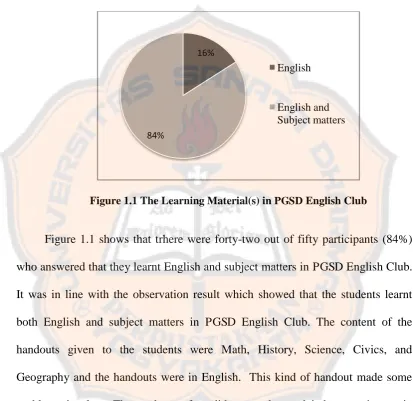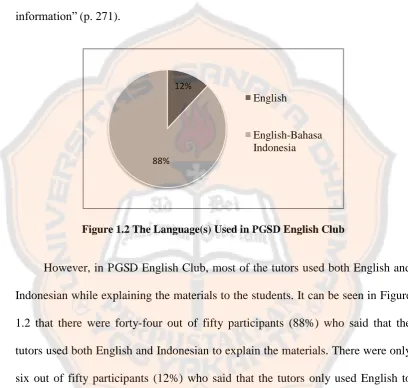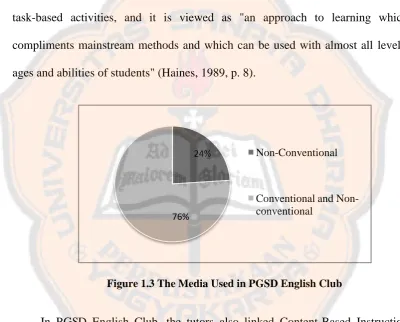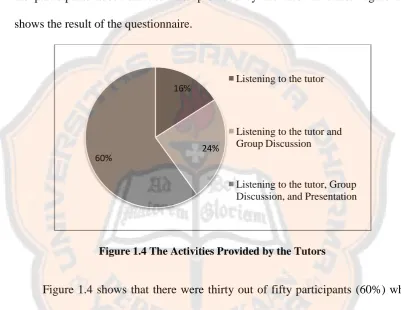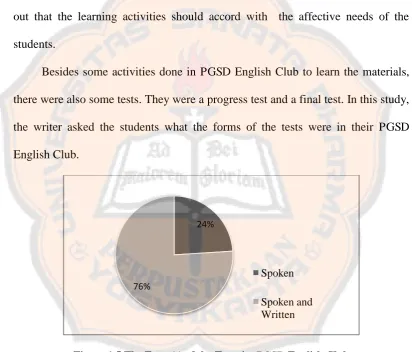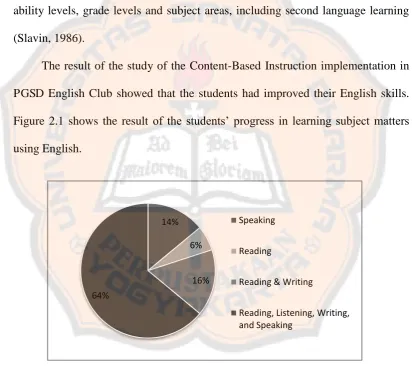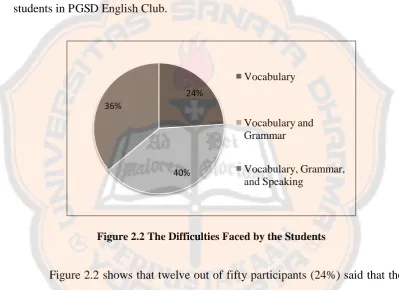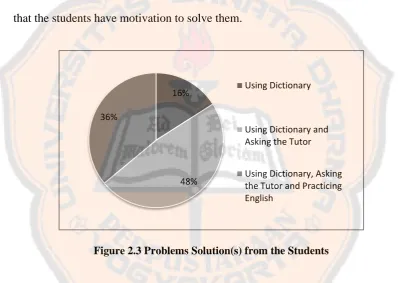i
THE IMPLEMENTATION OF CONTENT-BASED INSTRUCTION
IN PGSD ENGLISH CLUB OF SANATA DHARMA UNIVERSITY
A SARJANA PENDIDIKAN FINAL PAPER
Presented as Partial Fulfillment of the Requirements to Obtain the Sarjana Pendidikan Degree
in English Language Education
By Dewi Agustina Student Number: 091214089
ENGLISH LANGUAGE EDUCATION STUDY PROGRAM DEPARTMENT OF LANGUAGE AND ARTS EDUCATION FACULTY OF TEACHERS TRAINING AND EDUCATION
SANATA DHARMA UNIVERSITY YOGYAKARTA
ii
iii
iv
LEMBAR PERNYATAAN PERSETUJUAN
PUBIKASI KARYA ILMIAH UNTUK KEPENTINGAN AKADEMIS
Yang bertanda tangan di bawah ini, saya mahasiswa Universitas Sanata Dharma:
Nama : Dewi Agustina
Nomor Mahasiswa : 091214089
Demi pengembangan ilmu pengetahuan, saya memberikan kepada Perpustakaan Universitas Sanata Dharma karya ilmiah saya yang berjudul:
THE IMPLEMENTATION OF CONTENT-BASED INSTRUCTION IN PGSD
ENGLISH CLUB OF SANATA DHARMA UNIVERSITY
Dengan demikian saya memberikan kepada Perpustakaan Universitas Sanata Dharma hak untuk menyimpan, mengalihkan dalam bentuk media lain, mengelolanya dalam bentuk pangkalan data, mendistribusikan secara terbatas, dan mempublikasikannya di internet atau media lain untuk kepentingan akademis tanpa perlu meminta ijin dari saya maupun memberikan royalti kepada saya selama tetap mencantumkan nama saya sebagai penulis.
Demikian pernyataan ini yang saya buat dengan sebenarnya.
Dibuat di Yogyakarta
Pada tanggal: 15 Agustus 2013 Yang menyatakan
Dewi Agustina
v
STATEMENT OF WORK’S ORIGINALITY
I honestly declare that this paper, which I have written, does not contain the work or parts of the work of other people, except those cited in the quotations and the references, as a scientific paper should.
Yogyakarta, 15th August 2013
The Writer
vi
ABSTRACT
Agustina, Dewi. (2013). The Implementation of Content-Based Instruction in PGSD English Club of Sanata Dharma University. Yogyakarta: Sanata Dharma University.
Primary School Teacher Education or Pendidikan Guru Sekolah Dasar (PGSD) of Sanata Dharma University provides English Club every Saturday to help the students to increase their speaking skill. Considering the existence of international schools today, there is a new policy in English Club PGSD. It is
“Learning Subjects Using English”. Here, the students will learn Math, History, Science, Civics, and Geography using English and this approach is called as Content-Based Instruction. CBI is usually applied in a classroom where students use English as their second language. Unfortunately, English is not the second language of the students of PGSD of Sanata Dharma University. Therefore, it is worthy of note to find the implementation of CBI in English Club classes.
There were two research questions in this paper: (1) How is Content-Based Instruction implemented in PGSD English Club? and (2) What are the benefits of the implementation of Content-Based Instruction in PGSD English Club?
This research was included in quantitative research and conducted through a survey. The instruments that were used in gathering the data were a questionnaire and an observation checklist. The questionnaire was used to collect the data of the implementation of CBI in PGSD English Club and the benefits of CBI implementation in PGSD English Club. The observation checklist was used to support the data of the questionnaire on how Content-Based Instruction applied in PGSD English Club.
The findings showed that the tutors often switched the language from English to Bahasa Indonesia in the implementation of CBI in PGSD Club English. The implementation of CBI in PGSD Club was also incorporated with cooperative learning. The findings also showed that the implementation of CBI in
PGSD English Club had some benefits. The students were successful in developing their language skills through the content. Most of the students had progress in speaking, listening, reading, and also writing. The students also increased their motivation to learn English.
Keywords: English Club, Content-Based Instruction, Primary School Teacher Education Study Program
vii
ABSTRAK
Agustina, Dewi. (2013). The Implementation of Content-Based Instruction in PGSD English Club of Sanata Dharma University. Yogyakarta: Universitas Sanata Dharma.
Pendidikan Guru Sekolah Dasar (PGSD) di Universitas Sanata Dharma menyediakan English Club yang diselenggarakan setiap hari Sabtu untuk meningkatkan kemampuan berbicara siswa dalam berbahasa Inggris. Menyadari banyaknya keberadaan sekolah internasional pada saat ini, menimbulkan adanya kebijakan baru di English Club yaitu, “Mempelajari Peajaran Menggunakan
Bahasa Inggris”. Di sini siswa akan mempelajari Matematika, Sejarah, IPA,
Kewarganegaraan, dan Geografi menggunakan bahasa Inggris dan pendekatan ini desebut dengan Content-Based Instruction. CBI biasanya diterapkan pada kelas yang siswanya menggunakan bahasa Inggris sebagai bahasa kedua mereka. Namun, bahasa Inggris bukanlah bahasa kedua dari siswa PGSD Sanata Dharma. Oleh karena itu, penulis ingin meneliti bagaimanakah penerapan CBI di kelas
English Club PGSD.
Ada 2 rumusan masalah dalam penelitian ini: (1) Bagaimana penerapan
Content-Based Instruction di kelas English Club PGSD? dan (2) Apa saja manfaat yang diperoleh dari penerapan Content-Based Instruction di English Club PGSD?
Penelitian ini merupakan penelitian kuantitatif yang dillakukan melalui survey. Instrumen yang digunakan berupa kuisioner dan lembar observasi. Kuisioner digunakan untuk mengmpulkan data dari implementasi CBI di English Club PGSD serta manfaat dari penerapan CBI di English Club PGSD. Lembar observasi digunakan untuk mendukung data dari kuisioner mengenai bagaimana penerapan CBI di English Club PGSD.
Hasil menunjukkan bahwa para tutor sering mengubah penggunaan bahasa Inggris menjadi bahasa Indonesia pada penerapan CBI di English Club PGSD. Penerapan CBI di English Club PGSD juga digabungkan dengan pembelajaran kooperatif. Hasil juga menunjukkan bahwa penerapan CBI di English Club PGSD memiliki beberapa manfaat. Para siswa tetap berhasil meningkatkan kemampuan berbahasa Inggris mereka. Sebagian besar siswa memiliki kemajuan dalam berbicara, mendengarkan, membaca, dan juga menulis. Motivasi untuk belajar bahasa Inggris para siswa juga meningkat.
viii
ACKNOWLEDGEMENTS
Apart from the efforts of me, the success of any project depends largely on the encouragement and guidance of many others. I take this opportunity to express my gratitude to the people who have been instrumental in the successful completion of this final paper.
The greatest gratitude goes to my God, who always blesses me and makes me able to finish this paper. I would also like to express my sincere gratitude to my advisor Made Frida Yulia, S.Pd, M.Pd. for the continuous support to my study, for her patience, motivation, enthusiasm, and immense knowledge. Her guidance helped me in all the time of research and writing this final paper. I would also like to acknowledge with much appreciation the crucial role of the staff of PGSD English Club. Also, I like to thank the participants in my survey, who have willingly shared their precious time.
Furthermore, I would like to thank Vincensius Anggit Wicaksono for his willingness to be my proofreader, for his improving suggestions, and for his strengthening motivation. Also, I would like to thank F. Tri Wardani and F. Galih Permatasari, my very best friends, for supporting me throughout the entire process. My special gratitude goes to Nanda Suryawan, who is always beside me, helps me, and supports me to go through all the smiles and tears.
Last but not least, my overwhelming thanks are for my parents, Bapak
Agus R. and Ibu M. Dewi for the love and care since the first time I breathed, the prayer in every single tiring day and night, and the trust in everything I do.
ix
TABLE OF CONTENTS
Page
TITLE PAGE ... i
APPROVAL PAGES ... ii
PERNYATAAN PERSETUJUAN PUBLIKASI ... iv
ABSTRACT ... v
ABSTRAK ... vi
STATEMENT OF WORK’S ORIGINALITY ... vii
ACKNOWLEDGEMENTS ... viii
TABLE OF CONTENTS ... ix
LIST OF FIGURES ... x
LIST OF APPENDICES ... xi
CHAPTER I INTRODUCTION 1.1 Research Background ... 1
1.2. Research Method ... 4
CHAPTER II DISCUSSION 2.1 The Implementation of Content-Based Instruction in PGSD English Club ... 6
2.2 The Benefits of Content-Based Instruction in PGSD English Club ... 14
CHAPTER III CONCLUSIONS ... 20
x
LIST OF FIGURES
Figure Page
1.1 The Learning Material(s) in PGSD English Club ... 9
1.2 The Language(s) Used in PGSD English Club ... 10
1.3 The Media Used in PGSD English Club ... 11
1.4 The Activities Provided by the Tutors ... 12
1.5 The Form(s) of the Tests in PGSD English Club ... 13
2.1 The Students’ Progress in Learning ... 15
2.2 The Difficulties Faced by the Students ... 17
xi
LIST OF APPENDICES
Appendix Page
A. The Questionnaire ... 24
B. The Observation Checklist ... 26
C. The Syllabus of PGSD English Club ... 28
D. Sample of the Completed Questionnaire ... 31
E. Raw Data of the Questionnaire ... 34
1 CHAPTER I INTRODUCTION
In this part, the writer explains the background and the research method of this paper. The background provides the general information of the English usage in an education field, the writer’s reasons for choosing this topic, the research problems, and the benefits of this research. The research method, on the other hand, provides the description of samples, materials, and procedures.
1.1 Research Background
English is not something new in Indonesia. Many people are familiar with English and even children are familiar with it. English is not something that can be avoided. Everyone should learn English today because it is one of the subjects which should be learnt at school. English education has entered elementary school since 2003/2004. Nowadays, the usage of English is more developed. It is proved by the existence of international schools.
Most of the international schools have higher quality standards of teachers than the national schools do. The teachers have to be good in English because they will use English to teach the students. It is proved by some requirements set by the international schools when they start to recruit new teachers. The teachers must have the minimum score of Test of English as a Foreign Language (TOEFL) set by the international schools. They also set the job interview in English regardless of the subject that the new teachers will teach.
2
Realizing the existence of international schools, many teachers have to be ready to compete with others. If they cannot use English well, they will not be able to survive in this education field. This makes a concern for some universities to pay more attention to the English usage. The universities try to find a new strategy to develop their students’ ability to speak English. One of the universities which pay more attention to it is Sanata Dharma University.
Sanata Dharma University emphasizes English language proficiency for all students from English and non-English majors. One form of the English language test requirement for students in non-English majors is the spoken English competency test or Tes lisan Kemampuan Bahasa Inggris (TKBI). The students have to pass this test before they graduate from Sanata Dharma University.
In order to make the students ready for the TKBI, one of the study programs in Sanata Dharma University, Primary School Teacher Education Study Program or Pendidikan Guru Sekolah Dasar (PGSD), has an extracurricular activity named English Club (EC). Even though it is an extracurricular activity, this program is a compulsory activity for the students of PGSD of Sanata Dharma University in the first semester up to the fourth semester. They have to attend English Club once a week every Saturday morning.
3
will learn Math, History, Science, Civics, and Geography using English. It is an approach which integrates content and language learning. According to Brinton, Snow & Wesche (1989), this approach is called Content-Based Instruction (CBI).
CBI has connection with second language acquisition. One central
principle which supports the theory of second language acquisition is that “people
learn a second language more successfully when they use the language as a means
of acquiring information, rather than as an end in itself” (Richards & Rogers,
2005, p. 207). CBI is also usually applied in a classroom whose students use English as their second language and itis supported by Brinton et al. (1989, p. 2),
“CBI is the concurrent teaching of subject matter and second language skills.” Unfortunately, English is not the second language of the students of PGSD
of Sanata Dharma University. Therefore, the writer is going to find the implementation of CBI in each English Club class. It is expected that the writer will find some information about the CBI implementation in a classroom whose students do not use English as their second language. Also, the writer wants to know the benefits of CBI applied in PGSD English Club. It is expected that the findings can be a reference to evaluate CBI that has been implemented. These are the formulated problems;
1. How is Content-Based Instruction implemented in PGSD English Club?
2. What are the benefits of the implementation of Content-Based Instruction in PGSD English Club?
4
The writer hopes that this research will be beneficial for some parties. First is for the Primary School Teacher Education Study Program of Sanata Dharma University. It is expected that the findings can motivate the PGSD English Club committee to develop and evaluate the method that has been implemented. Second is for English Education, especially for English teacherswho want to apply CBI in their classroom although the students do not use English as their second language. It is expected that the English teachers can use the findings to choose the best strategy to use in their class.
1.2. Research Method
This research was a survey. Survey is “the systematic gathering of information from (a sample of) respondents for the purpose of understanding and/or predicting some aspects of the behavior of the population of interest” in certain topic of problem (Tull & Albaum, 1973, p. 3). The writer used a questionnaire and an observation checklist as the instruments. The questionnaire was used to examine the implementation of in PGSD English Club and the benefits of the implementation of Content-Based Instruction in PGSD English Club. The class observation was conducted to support the data from the questionnaire about the implementation of Content-Based Instruction in PGSD
English Club.In conducting the class observation, the writer used an observation checklist to examine how Content-Based Instruction was applied in PGSD
English Club.
The questionnaire was distributed to fifty students who joined PGSD
5
were twelve classes and each class had around seventeen students in PGSD
English Club. The writer chose five classes randomly. The writer gave the questionaire to five tutors. Each tutor got ten quetionaires and he gave it to his students randomly.
There were three main steps in conducting this study. The first step was distributing the questionnaire. The questionnaire was distributed by the tutor to the students after the class. The questionnaire only took ten to fifteen minutes to be completed. The questionnaire was used to collect the data of the implementation and the benefits of CBI in PGSD English Club. The second step was observing eight classes in PGSD English Club. While observing the class, the writer used the observation checklist to support the data of the questionnaire on how Content-Based Instruction was applied in PGSD English Club. The third step was analyzing and interpreting the data. The data obtained from two previous stepswere analyzed and interpreted then stated as a conclusion.
6
CHAPTER II DISCUSSION
This part contains review of related literature and findings as well as the interpretation of the findings. Review of related literature provides the relevant theories of this research paper. It is followed by the results and the interpretation of the data.
2.1 The Implementation of Content-Based Instruction in PGSD English Club
The term Content-Based Instruction, which was implemented in PGSD
English Club, refers to an approach to integrating content and language learning (Brinton, Snow & Wesche, 1989). In PGSD English Club, the tutors integrated the subject matters and English. Here, the tutors had to teach subject matters using English.
The focus for students is on aquiring information via the target language and developing their academic language skills in the process. Ultimately, the goal is to enable students to transfer these skills to other academic courses given in the target language. Thus, both in its overall purpose and its implementation, Content-Based Instruction aims at “eliminating the artificial separation between language
instruction and subject matter classes which exists in most educational settings”
Brinton et al. (1989, p. 2).
7
the use of the target language. It is supported by Leaver & Stryker (1989) who agree that Content-Based Instruction suggestions are bound to meet four basic characteristics:
(1) subject matters core —the fundamental organization of the curriculum should be derived from the subject matters, rather than from forms, functions or situations; (2) use of authentic texts —the core materials (texts, video tapes, audio recordings, visual aids, etc.) should be selected primarily (though not exclusively) from those produced for native speakers of the language; (3) learning of new information —students should use the second/foreign language to learn new information and to evaluate that information, based on knowledge of their own culture (C1) and their own emerging cultural literacy in the second culture (C2), and (4) appropriate to the specific needs of students —the topics, content, materials, and learning activities should correspond to the cognitive and affective needs of the students and should be appropriate to the proficiency level of the class (p. 271).
The previous four characteristics agreed by Leaver & Stryker (1989) were found in PGSD English Club. The curriculum was based on content and it was the subject matter. It could be seen from the syllabus which had topics and sub-topics related to the subject matters. The topics were Math, History, Science, Civics, and Geography. The sub-topics were number and currency, national history, life cycle, parts of human body, life value, and governmental hierarchy. Some of the learning media such as video, film, and song which were performed by the native speaker of English were used to learn the new information. The students had to use English to learn the new information and they had to comprehend the materials given. Since PGSD students were prepared to be an elementary school teacher, the materials used in PGSD Engish Club were related to the materials that they would teach to the students in elementary school.
8
Content-Based Instruction is supported by the second language acquisition research. One central principle which supports the theory of second language
acquisition is that “people learn a second language more successfully when they
use the language as a means of acquiring information, rather than as an end in
itself” (Richards & Rogers, 2005, p. 207). Based on Met (1991), natural language acquisition occurs in the context, which is never learnt divorced from meaning, and Content-Based Instruction provides a context for meaningful communication to occur. It involves the teaching of academic subject matters and second language skills. The students, thus, receive curricular information and do their academic tasks in the target language and at the same time acquire the target language in a very natural way, that is “eliminating the separation between curricular
development and the study of the L2 or TL” (Madrid, 2001, p. 115).
Unfortunately, though the students learnt English and subject matters at the same time, the students still received the subject matters both in the target language and their native language. It was because English was not students’ second language but it was their foreign language. English was taught as a school subject, but it was not used as a means of instruction nor as a language of communication in the community. This was an important factor that made the implementation of Content-Based Instruction in PGSD English Club being different. The tutors and the students still used their native language in the teaching and learning processes.
In order to find the implementation of Content-Based Instruction in PGSD
9
obtain the data. In order to assure that PGSD English Club was really using Content-Based Instruction as the approach, the writer asked a fundamental question about what the students learnt in PGSD English Club.
Figure 1.1 The Learning Material(s) in PGSD English Club
Figure 1.1 shows that trhere were forty-two out of fifty participants (84%) who answered that they learnt English and subject matters in PGSD English Club. It was in line with the observation result which showed that the students learnt both English and subject matters in PGSD English Club. The content of the handouts given to the students were Math, History, Science, Civics, and Geography and the handouts were in English. This kind of handout made some problems in class. The students often did not understand it because it was in English. The tutor, thus, used Indonesian to explain it.
In order to know the details of the Content-Based Instruction implementation in PGSD English Club, the writer provided a question in the questionnaire. It was what language the tutors used to explain the materials. Since the course used CBI, the students were supposed to receive the information in the
16%
84%
English English and Subject matters
10
target language (Madrid, 2001). It means that the tutors are supposed to use English to deliver the materials just like what Leaver & Stryker (1989) point out
that “students should use the second/foreign language to learn the new
information”(p. 271).
Figure 1.2 The Language(s) Used in PGSD English Club
However, in PGSD English Club, most of the tutors used both English and Indonesian while explaining the materials to the students. It can be seen in Figure 1.2 that there were forty-four out of fifty participants (88%) who said that the tutors used both English and Indonesian to explain the materials. There were only six out of fifty participants (12%) who said that the tutors only used English to explain the materials. The result of the observation was in line with the result of the questionnaire. It showed that most of the tutors not only used English and Indonesian to explain the materials but most of them sometimes also used Indonesian to communicate with the students.
Adoption of Content-Based Instruction allows language educators to incorporate language functions, skills, vocabulary, and grammar into language
12%
88%
English
11
classes. Content-Based Instruction is often linked with project work, which
“involves multi-skill activities focusing on a theme of interest rather than specific
language tasks” (Haines, 1989, p. 7). It is emphasized that different types of
projects have the same common features: students' interaction, collaboration, involvement, and responsibility. Project work implies cooperative learning and task-based activities, and it is viewed as "an approach to learning which compliments mainstream methods and which can be used with almost all levels, ages and abilities of students" (Haines, 1989, p. 8).
Figure 1.3 The Media Used in PGSD English Club
In PGSD English Club, the tutors also linked Content-Based Instruction with project work through the media. Figure 1.3 showed that there were thirty eight out of fifty participants (76%) who said that the tutors used both non-conventional and non-conventional media. The tutors used pictures, handouts, films, videos, songs, and PowerPoints as the learning media. On the other hand, twelve out of fifty participants (24%) said that the tutors only used the conventional
24%
76%
Non-Conventional Conventional and Non-conventional
12
media. Nevertheless, it means that all of the tutors have used media to teach subjects in PGSD English Club.
In order to know more about the activities done in the class, the writer asked the participants about the activities provided by the tutor in class. Figure 1.4 shows the result of the questionnaire.
Figure 1.4 The Activities Provided by the Tutors
Figure 1.4 shows that there were thirty out of fifty participants (60%) who said that the tutors provided some kinds of activities. They were listening to the tutor, doing the group discussion, and doing the presentation. There were also twelve out of fifty participants (24%) who said that the tutors provided two kinds of activities. They were listening to the tutor and doing some group discussions. Here, the tutors incorporated CBI with cooperative learning. The students were not only listening to the tutor’s explanation but they also interacted with their friends in a group discussion. They could learn from their friends. The source was not only the tutor but also their friends. By having this kind of activity, they also
16%
24% 60%
Listening to the tutor
Listening to the tutor and Group Discussion
13
created a warm environment in the class. They tried to respect others’ opinions
and tried to solve problems together.
Nonetheless, there were eight of fifty participants (16%) who said that the tutors only provided an activity. The students were only listening to the tutor and had no other activities. It is not in line with what Leaver & Stryker (1989) point out that the learning activities should accord with the affective needs of the students.
Besides some activities done in PGSD English Club to learn the materials, there were also some tests. They were a progress test and a final test. In this study, the writer asked the students what the forms of the tests were in their PGSD
English Club.
Figure 1.5 The Form(s) of the Tests in PGSD English Club
According to Figure 1.5, thirty-eight out of fifty participants (76%) said that the forms of the tests were written and spoken. Twelve out of fifty participants (24%) said that the form of the tests was only spoken. Spoken test is a good form of a test because the students will use the language as a communication tool and people learn a language more successfully when they use the language as a means
24%
76%
Spoken Spoken and Written
14
of acquiring information (Richards & Rogers, 2005, p. 207). The combination of spoken and written tests will be better to learn a language. The students can practice using the language in speaking and also know how to use it in the written form.
2.2 The Benefits of Content-Based Instruction in PGSD English Club
Based on the previous discussion about the implementation of Content-Based Instruction in PGSD English Club, the tutors not only integrated the language and the content but they also incorporated Content-Based Instruction with cooperative learning which would lead the students to receive more benefits. The students could learn from their friends, the source was not only from the tutor but also from their friends. The students also created a warm environment in the class by having a group discussion. The students learnt to respect others’ opinions and tried to solve the problems together. Having a group discussion also helped the students to develop their speaking skill because they were forced to be able to speak.
15
also reveal affective benefits. Cooperative learning results in students’ feeling
greater mutual concern for each other and an overall greater liking of school, as compared to students who receive traditional teaching techniques. Cooperative learning also improves race relations and individual student self-esteem. Higher achievement in students who learn through cooperative learning is found across ability levels, grade levels and subject areas, including second language learning (Slavin, 1986).
The result of the study of the Content-Based Instruction implementation in
PGSD English Club showed that the students had improved their English skills. Figure 2.1 shows the result of the students’ progress in learning subject matters using English.
Figure 2.1 The Students’ Progress in Learning
Figure 2.1 shows that there were thirty-two out of fifty participants (64%) who said that they made progress in speaking, listening, reading, and also writing. With the Content-Based Instruction, the students were encouraged to think and learn through the use of English by integrating the four traditional language skills
16
(listening, speaking, reading and writing). The students practised authentic reading, listened to the tutor's comments and spoke about the content. Finally, they wrote certain tasks to consolidate what they had previously listened to. In addition to that, the students interpreted and evaluated the information provided, studied and learnt facts, and developed a variety of receptive and productive procedures which prepared them for the range of academic demands they would have to face with.
There were eight out of fifty participants (16%) who said that they made progress in reading and writing. There were seven out of fifty participants (14%) who said that they made progress only in speaking while three out of fifty participants (6%) said that they made progress only in reading. Nevertheless, it showed that the students succeeded in developing their language skill through the content.
17
conventional textbook content, but make use of a wide variety of viable texts from different sources, thus promoting student autonomy and empowerment.
Despite making progress in their English skils, the students of PGSD
English Club also faced some difficulties while learning subject matters using English. The writer used the questionnaire to find out the difficulties faced by the students in PGSD English Club.
Figure 2.2 The Difficulties Faced by the Students
Figure 2.2 shows that twelve out of fifty participants (24%) said that they had a problem with the vocabularies. There were twenty out of fifty participants (36%) who said that they had difficulties in vocabulary and grammar. There were eighteen out of fifty participants (40%) had difficulties in vocabulary, grammar, and speaking. There were a lot of vocabularies that the students did not know. The students also did not have good grammar and it made some problems when the students were doing the writen or spoken tasks. Since the course used Content-Based Instruction, the students did not learn the language explicitly and it became a problem because most of the students did not have good basic grammar. This
24%
40% 36%
Vocabulary Vocabulary and Grammar
Vocabulary, Grammar, and Speaking
18
two problems could lead to another problem. The students was afraid to speak English and this was the biggest problem in PGSD English Club.
There is a saying that people learn from problems. It means that some
problems faced by the students are not bad things. It can create students’
motivation to learn English. In order to prove it, the writer asked how the participants handled the difficulties. By trying to handle the difficulties, it means that the students have motivation to solve them.
Figure 2.3 Problems Solution(s) from the Students
Based on the result, there were eight out of fifty participants (16%) who handled the difficulties by checking the dictionary and there were twenty-four out of fifty participants (48%) who handled the difficulties by checking the dictionary and also asking to the tutor. The other eighteen participants (36%) also did that, but they added a way to handle the problems by practicing English with their friends inside and outside the class. Here, the students had their own motivation to do it. It is in line with Grabe and Stoller (1997) who point out that in
Content-16%
48% 36%
Using Dictionary
Using Dictionary and Asking the Tutor
19
Based Instruction, “students are exposed to complex information and are involved in demanding activities which can lead to intrinsic motivation” (p. 19).
Moreover, motivation and interest research has found out that “motivation and interest come, in part, from the recognition that (1) one is actually learning and that (2) one is learning something valuable and challenging that justifies the
effort” (Dupuy, 2000, p. 207). In line with this, Content-Based Instruction attempts to respond to the needs and interests of learners by focusing either on subject matters that are related to their own pedagogical or academic needs, or on content spheres which are associated with the students’ cognitive and affective preferences. Furthermore, students with high level of motivation make more sophisticated elaborations with learning materials, increase connections among content information, and are able to recall information more easily and better.
20
CHAPTER III
CONCLUSIONS
In this chapter, the researcher is going to summarize the major findings of this study. Based on the findings, PGSD English Club uses Content-Based Instruction as the approach. The target language is English and the content is the subject matter such as Math, History, Science, Civics, and Geography.
In the implementation of CBI in PGSD English Club, the tutors often switch the language from English to Indonesian in the teaching and learning process to
make the students understand. It is because English is not students’ second
language but English is students’ foreign language. In this case, the students need to learn more about English and increase their English skill first. The students need enough base of English so that the tutors of PGSD English Club can implement CBI using the target language only.
CBI is incorporated with cooperative learning in PGSD English Club. The
students are not just listening to the tutor’s explanation but they can interact with
their friends in a group discussion. By having the group discussion, the students can learn from their friends. The source is not only from the tutor but also from their friends. They also create a warm environment in the class by having this
activity. They learn to respect others’ opinion and try to solve the problem
together.
21
listening, reading, and also writing. One of the aspects is related to the media used by the tutor. The tutors not only use conventional media but also non-conventional media. Having non-conventional media such as handout, the students can develop their reading and writing skill. By providing non-conventional media, the students can develop their English skills more. By watching films, listening songs, listening to the tutor, the students develop their listening skill. Here, the tutors not only vary the media but also vary the activities for example, by having a group discussion. Having group discussion can help the students to develop their speaking skill because they are forced to be able to speak.
The form of the test also helps the students to increase their speaking and writing skill. By having a written test, the students are motivated to have a good writing skill and by having an oral test, the students are motivated to have a good speaking skill.
22
REFERENCES
Ary, D., Jacob, L., & Razavieh, A. (2002). Introduction to research in education. Belmont, CA: Wadsworth Thompson Learning.
Ballman, L. (1997). Enhancing beginning language courses through content-enriched instruction. Foreign Language Annals, 30(2), 173-186.
Brinton, D., Snow M., & Wesche, M. (1989). Content-based second language instruction. New York: Newbury House.
Crawford, M. (2001). Making language meaningful: A content-based approach for teaching general English courses. Journal of Hokkaido University of Education, 52(1), 53-63.
Duenas, M. (2005). The whats, whys, hows and whos of content-based instruction in second/foreign language education. International Journal of English Studies, 4 (1), 73-96.
Dupuy, B. (2000). Content-based instruction: Can it help ease the transition from beginning to advanced foreign language classes? Foreign Language Annals, 33(2), 205-222.
Echevarria, J., & Graves, A. (2003). Sheltered content instruction: Teaching English-language learners with diverse abilities. Boston: Allyn & Bacon. Grabe, W., & Stoller, F. & (1997). A six T’s approach to content-based
instruction. New York: Addison Wesley-Longman.
Greenfield, K., & Sagliano, M. (1998). A collaborative model of content-based EFL instruction in the liberal arts. TESOL Journal 7(3), 23-28.
Haines, S. (1989). Projects for the EFL classroom: Resource material for teachers. Walton-on-Thames Surrey: Nelson.
Leaver, B. & Stryker, S. (1989). Content-based instruction for foreign language classrooms. Foreign Language Annals, 22(3), 269-275.
Lonon-Blanton, L. (1992). A holistic approach to college ESL: Integrating language and content. ELT Journal, 46, 285-293.
23
Met, M. (1991). Learning language through content: Learning content through language. Foreign Language Annals, 24, 281-295.
Met, M., Genesee, F., & Snow, M. (1989). A conceptual framework for the integration of language and content in second/foreign language instruction.
TESOL Quarterly, 23, 201-217.
Moser, J., & Raphan, C. (1994). Linking language and content: ESL and art history. TESOL Journal, 3(2), 17-21.
Richards, J., & Rogers, T. (2005). Approaches and methods in language teaching.
New York: Cambridge University Press.
Rivers, M. (1992). Communicating naturally in a second language, theory and practice in language teaching. New York: Cambridge University Press. Short, D. (1991). Integrating language and content instruction: Strategies and
techniques. NCBE Program Information Guide Series, 7, 1-23.
Slavin, E. (1980). Cooperative learning. Review of Educational Research, 50(2), 315-342.
Snow, M. (1998). Trends and issues in content-based instruction. Annual Review of Applied Linguistics, 1, 243-267.
Spanos, G. (1987). On the integration of language and content instruction. Annual Review of Applied Linguistics, 10, 227-240.
Stoller, F. (1997). Project work: A means to promote language content. English Teaching Forum, 35(4), 2-9.
Tull, S., &, Albaum S. (1973). Survey research: A decisional approach. New York: Intext Educational Publisher.
24
Appendix
A
25
KUISIONER
Jawablah pertanyaan di bawah ini dengan jawaban yang menurut Anda paling sesuai. Berikan tanda (√) pada yang tersedia. Anda dapat memberikan lebih dari satu tanda (√) pada setiap nomor.
Pertanyaan
Jawaban
1.Apa yang anda pelajari di English Club?
a. Bahasa
(grammar, pronunciation, dll.) b. Mata Pelajaran
(Matematika, IPA, IPS, dll.) 2.Bahasa apa yang digunakan tutor
ketika menjelaskan materi?
a. Inggris b. Indonesia 3.Apa saja media yang digunakan
untuk menjelaskan materi di kelas?
a. Konvensional (gambar, handout, dll.) b. Non-konvensional (film, video, Power
Point, dll.) 4.Apa saja kegiatan yang
diberikan oleh tutor untuk 5.Apa saja bentuk tes yang Anda
kerjakan di English Club?
a. Tes tertulis b. Tes lisan
c. Lain-lain___________________________ 6. Kemampuan berbahasa Inggris
Anda yang manakah yang 7.Apa saja kesulitan Anda dalam
mempelajari mata pelajaran lain menggunakan Bahasa Inggris?
a. Banyak kosa kata yang tidak paham b. Tidak paham struktur Bahasa Inggris c. Takut berbicara menggunakan Bahasa
Inggris
d. Lain-lain__________________________ _________________________________ 8.Bagaimana cara Anda mengatasi
masalah-masalah tersebut?
a. Membuka kamus b. Bertanya pada tutor
c. Berlatih berbicara menggunakan Bahasa Ingris dengan teman
26
Appendix
B
27
OBSERVATION CHECKLIST
Day/date : _________________________________ Class/meeting : _________________________________
Put a tick (√) in the Observed / Unobserved columns to represent your evaluation
on the items.
Description Observed Unobserved Note
1. The students learn
7. The tutor varies the activities done in class.
28
Appendix
C
29
English Club of PGSD
Sanata Dharma University
Time Allocation : 2 x 50 minutes class meeting
Competence Standard
Students are able to deliver short speech in form of storytelling related to the main subjects taught in PGSD.
Basic Competence
Students are able to:
Identify basic vocabularies related to Math
Formulate and then deliver simple speech in form of storytelling related to Math Identify common vocabularies related to Social Science
Formulate and then deliver simple speech in form of storytelling related to Social Science
Identify basic vocabularies related to Science
Formulate and then deliver simple speech in form of storytelling related to Science
Identify basic vocabularies related to Civics
Formulate and then deliver simple speech in form of storytelling related to Civics
2 Number and Currency
10 3
Social Science : History National History
17 4 National History
Social Science : Geography Governmental hierarchy
12 12 Governmental hierarchy
19 13
Science Part of Human Body
26 14 Part of Human Body
2 June 15
Final Test
9 16
*schedule and learning activities are subject to change
30
Learning Strategies:
Teaching-learning activities are mostly dealing with speaking exercises, vocabulary drilling, question and answer, and discussion. Each student is required to bring dictionary(s).
Rules of Conduct:
During the class cell phones must be deactivated or at least switched into silent mode.
No texting during the class. Do ’t be late ( ax. inutes).
Students must present during all the class activities. Should the students be absent, it will be no more than 3 times (for sickness and other reasons). Students must participate in all class activities actively.
The penalty for the late submission of the assignments is 10-point-reduction from the total score one deserves.
Grading Policy:
Grade Evaluation
A : 80 – 100 Quiz : 20%
B : 70 – 79 Assignment : 20%
C : 60 – 69 Part. &
Attend.
: 15%
D : 50 – 59 Game : 15%
E : < 49 Final Test : 30%
31
Appendix
D
SAMPLE OF
QUESTIONNAIRE
32
KUISIONER
Jawablah pertanyaan di bawah ini dengan jawaban yang menurut Anda paling sesuai. Berikan tanda (√) pada yang tersedia. Anda dapat memberikan lebih dari satu tanda (√) pada setiap nomor.
Pertanyaan
Jawaban
1.Apa yang anda pelajari di English Club?
a. Bahasa
(grammar, pronunciation, dll.) b. Mata Pelajaran
(Matematika, IPA, IPS, dll.) 2.Bahasa apa yang digunakan tutor
ketika menjelaskan materi?
a. Inggris b. Indonesia 3.Apa saja media yang digunakan
untuk menjelaskan materi di kelas?
a. Konvensional (gambar, handout, dll.) b. Non-konvensional (film, video, Power
Point, dll.) 4.Apa saja kegiatan yang
diberikan oleh tutor untuk 5.Apa saja bentuk tes yang Anda
kerjakan di English Club?
a. Tes tertulis b. Tes lisan
c. Lain-lain___________________________ 6. Kemampuan berbahasa Inggris
Anda yang manakah yang 7.Apa saja kesulitan Anda dalam
mempelajari mata pelajaran lain menggunakan Bahasa Inggris?
a. Banyak kosa kata yang tidak paham b. Tidak paham struktur Bahasa Inggris c. Takut berbicara menggunakan Bahasa
Inggris
d. Lain-lain__________________________ _________________________________ 8.Bagaimana cara Anda mengatasi
masalah-masalah tersebut?
a. Membuka kamus b. Bertanya pada tutor
c. Berlatih berbicara menggunakan Bahasa Ingris dengan teman
33
KUISIONER
Jawablah pertanyaan di bawah ini dengan jawaban yang menurut Anda paling sesuai. Berikan tanda (√) pada yang tersedia. Anda dapat memberikan lebih dari satu tanda (√) pada setiap nomor.
Pertanyaan
Jawaban
6.Apa yang anda pelajari di English Club?
c. Bahasa
(grammar, pronunciation, dll.) d. Mata Pelajaran
(Matematika, IPA, IPS, dll.) 7.Bahasa apa yang digunakan tutor
ketika menjelaskan materi?
c. Inggris d. Indonesia 8.Apa saja media yang digunakan
untuk menjelaskan materi di kelas?
c. Konvensional (gambar, handout, dll.) d. Non-konvensional (film, video, Power
Point, dll.) 9.Apa saja kegiatan yang
diberikan oleh tutor untuk 10. Apa saja bentuk tes yang
Anda kerjakan di English Club?
d. Tes tertulis e. Tes lisan
f. Lain-lain___________________________ 9. Kemampuan berbahasa Inggris
Anda yang manakah yang 10. Apa saja kesulitan Anda
dalam mempelajari mata pelajaran lain menggunakan Bahasa Inggris?
e. Banyak kosa kata yang tidak paham f. Tidak paham struktur Bahasa Inggris g. Takut berbicara menggunakan Bahasa
Inggris
c. Berlatih berbicara menggunakan Bahasa Ingris dengan teman
34
Appendix
E
RAW DATA
35
RAW DATA OF QUESTIONNAIRE
Question Answer Respondents
1. What do you learn in English Club?
Language 12 Language and Subject Matters 26 2. What language does the tutor use to
explain the material?
English-Indonesian 32 English 6 3. What are the media used by the tutor
to explain the material in the class?
Conventional and
Non-conventional 30 Non-conventional 8 4. What are the activities provided by
the tutor in order to help the students to understand the material in the class?
Listening to the tutor 8 Listening to the tutor , Group
discussion, and Presentation 30 5. What are the forms of your tests in
English Club?
Written test 4 Oral test 7 Written and Oral test 28 6. In which English skill do you make
progress after learning subject matter using English?
Speaking 3 Speaking, Listening, Reading,
and Writing 35 7. What are your difficulties in learning
subject matters using English?
Vocabularies and Grammar 20 Vocabularies, Grammar, and
Speaking 18 8. How do you handle the difficulties?
Using dictionary and asking
tutor 19 Using dictionary, asking tutor
and practicing English 19
36
Appendix
E
RAW DATA
37
RAW DATA OF OBSERVATION
Description Note
1. The students learn
subject matters. The students learn history.
2. English is learnt implicitly.
Most of the tutors don’t explain the Engish grammar,
but the tutors often translate the words from English into Indonesian.
3. The tutor always uses English to explain the materials.
Most of the tutors use both English and Indonesian to explain the material. The tutors often translate some words from English into Indonesian.
4. The tutor always uses English to
communicate with the students.
The tutors use English to communicate with the students, but when the students look confused, the tutors switch the language from English into Indonesian.
5. The tutor uses conventional media.
All of the tutors use handout and the handout is in English. Some of the tutors also use pictures.
6. The tutor uses
non-conventional media. Most of the tutors use video and PowerPoint.
7. The tutor varies the activities done in class.
Most of the tutors ask the students to do some
